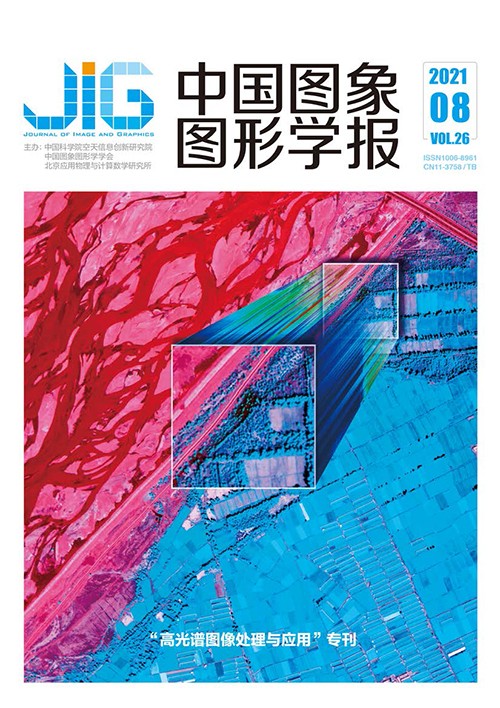
高光谱图像深度模糊核聚类的洋底锰结核识别
张启忠1,2, 郑恩迪1,2, 王叶剑3, 高发荣1,2(1.杭州电子科技大学水下智能装备实验室, 杭州 310018;2.杭州电子科技大学自动化学院, 杭州 310018;3.自然资源部第二海洋研究所, 杭州 310012) 摘 要
目的 海洋资源调查是海洋科学研究的重要组成部分,对于开发利用海洋资源、保护海洋环境有重要意义。将深海高光谱图像用于调查洋底锰结核资源,相比传统图像方法信息更为全面,识别更为准确。但是高光谱方法中用于有监督分类识别的分类器需要人工标定的标签,这在深海环境中是较为困难的。针对这一局限性,本文提出了一种融合深度网络与模糊核聚类的深度模糊核聚类(deep kernel fuzzy C-means,DKFCM)算法,实现对洋底锰结核高光谱图像的无监督聚类。方法 DKFCM由随机深度卷积网络(Rdnet)及改进的模糊核聚类算法两大模块组成。Rdnet通过降维、随机图块卷积及非线性激活操作的循环,实现对高光谱图像浅层及深层特征的提取,融合这两类特征作为后续聚类识别的输入。改进的模糊核聚类算法先用欧氏距离计算初始聚类中心,再用模糊核聚类的方法以实现海洋资源的准确分类。结果 实验结果表明,DKFCM无监督聚类能有效聚类洋底资源,对锰结核的聚类准确率达到76.59%,相比单用K-means聚类提高了20.99%,相比经Rdnet提取特征后再用K-means聚类提高了13.76%,对比实验表明DKFCM算法在无标签数据的情况下也能达到良好的准确率。结论 本文所提的高光谱深度模糊核聚类方法,实现了深海锰结核的无监督聚类,可以用于海洋资源量的评估。
关键词
Recognition of ocean floor manganese nodules by deep kernel fuzzy C-means clustering of hyperspectral images
Zhang Qizhong1,2, Zheng Endi1,2, Wang Yejian3, Gao Farong1,2(1.Laboratory of Underwater Intelligent Equipment, Hangzhou Dianzi University, Hangzhou 310018, China;2.School of Automation, Hangzhou Dianzi University, Hangzhou 310018, China;3.Second Institute of Oceanography, Ministry of Natural Resources, Hangzhou 310012, China) Abstract
Objective Marine resource survey is an important component of marine scientific research, which is of great significance to the development and utilization of marine resources and the protection of the marine environment. Polymetallic nodules, otherwise known as manganese nodules, are commonly distributed in the submarine plains of the water depth of 4~6 km. These nodules contain metallic elements, such as manganese, nickel, copper, and cobalt. Polymetallic nodules are regarded as an important oceanic mineral resource. The rich metallic elements of these nodules are relatively rare in terrestrial resources, but they are widely used. Influential countries and research institutions are currently conducting forward-looking investigations on the potential of deep-sea manganese nodules in view of its crucial strategic value. Traditional methods for investigating manganese nodules on the ocean floor are based on mechanical sampling, multi-beam acoustic remote sensing, and optical images. In recent years, the application of hyperspectral imaging technology in deep-sea resource surveys has gradually attracted the attention of researchers. Hyperspectral image refers to the integration of hundreds of continuous spectral bands and high-resolution image data. Each pixel corresponds to a continuous spectral curve, and objects of different materials obtain their unique "optical fingerprints". Using deep-sea hyperspectral images to investigate manganese nodule resources on the ocean floor has more comprehensive information and accurate identification than traditional image methods. This situation is precisely because many prospecting methods based on hyperspectral images have been proposed and applied to the investigation of ocean floor manganese nodules, such as the active hyperspectral imager mounted underwater, due to the superiority of these images in spectral characteristics compared with ordinary images. Platforms or remotely operated submersibles conduct surveys of seabed resources. At present, most processing methods for underwater hyperspectral images use supervised learning methods. However, supervised classification requires the addition of prior data. The following two problems occur in the investigation of marine resources:first, samples are sometimes difficult to obtain, and a perfect spectral database of seabed resources is lacking; second, underwater data are often complicated, and the result of manual calibration largely depends on the experience of the calibration personnel. This condition is vulnerable to interference from certain factors, such as fatigue, chromatic aberration, and environment, and the result will be a larger error. To address this limitation, this work proposes a deep kernel fuzzy C-means (DKFCM) clustering algorithm that combines deep network and fuzzy kernel clustering to realize unsupervised clustering of hyperspectral images of ocean floor manganese nodules. Method To extract more effective hyperspectral deep features, the DKFCM algorithm adds a random deep convolutional network Rdnet before improving the fuzzy kernel clustering algorithm to extract the deep spectral information about deep-sea hyperspectral images and use them for hyperspectral image clustering. In the feature extraction network part, the information redundancy is large because the hyperspectral image is composed of a substantial amount of relevant narrow-band spectral information. The huge spectral information can be compressed, the calculation speed is raised, and the calculation cost of the convolution operation is reduced through the dimensionality reduction operation with the principal component analysis(PCA). Then, data after PCA are convolved by randomly selecting some pixels from the data and cutting out a square image around it as the convolution kernel. After the random block convolution operation, the ReLU nonlinear activation function is added to improve the overall feature sparsity. Finally, the first layer of features is obtained. The above-mentioned dimensionality reduction, convolution, and nonlinear activation operations are repeated to extract deeper features. The shallow and deep features are merged as input features for subsequent classification. The clustering algorithm easily becomes unstable and fall into a local optimum because the initial clustering center of the KFCM algorithm is randomly selected. To improve this problem, the improved KFCM algorithm proposed in this work uses the Euclidean distance to measure the similarity and sets the distance between the initial cluster centers as far as possible. The initial cluster centers are finally iterated depending on this rule, and the clustering operation is performed. Finally, the accuracy of manganese nodules was obtained by separating and comparing each kind of substance. Result The experiment is divided into three groups for comparison. The clustering algorithms used are K-means clustering, DKmeans (K-means clustering through Rdnet), and the DKFCM clustering proposed in this work. Results show that DKFCM unsupervised clustering can effectively cluster ocean floor resources. In combination with the image data, the accuracy rate of manganese nodules is 76.59%. The overall number of correct nodules increases, the number of false clustering is relatively minimal, and the cluster results are the best. The accuracy of this algorithm is increased by 20.99% compared with K-means clustering. Meanwhile, the accuracy of the algorithm is increased by 13.76% compared with DKmeans clustering. This finding proves that the DKFCM algorithm can achieve high accuracy even without labeled data. Conclusion The hyperspectral deep fuzzy kernel clustering method proposed in the thesis, which combines deep convolutional network and improved kernel fuzzy clustering method, can extract deep features from deep sea hyperspectral data and use it for clustering. Experimental results show that the DKFCM algorithm realizes unsupervised clustering of deep-sea manganese nodules, which can be utilized for the assessment of marine resources, in the absence of seabed tag data.
Keywords
hyperspectral image deep learning convolutional network feature extraction clustering manganese nodules
|



 中国图象图形学报 │ 京ICP备05080539号-4 │ 本系统由
中国图象图形学报 │ 京ICP备05080539号-4 │ 本系统由